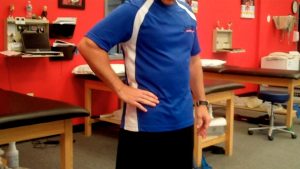Brian Schiff’s Blog
Injury Prevention, Sports Rehab & Performance Training Expert
Improving proximal hip stability and reducing frontal plane collapse is critical for protecting the knee. Poor frontal plane control often contributes to anterior knee pain, IT band syndrome, shin splints, plantar fasciitis and other injuries. This exercise is an advance progression of the standing pallof press, and it is very effective for enhancing single leg strength as well as hip/core stability.
Click here to read my full column on this exercise in PFP Magazine.
I find that many patients and clients lack dynamic shoulder and pillar stability. Assessing this with tall plank arm taps or tall plank Y reaches can tell you a lot about one’s ability to stabilize and resist gravity in single arm support. In light of the insufficiencies I see, I prefer to use exercises that encourage integrated shoulder, torso and hip stability.
Improving shoulder and torso stability is important for overhead athletes, wrestlers, MMA competitors as well as those with any shoulder instability. This exercise is a great way to build dynamic stability and postural stability.
Click here to read my entire online column for PFP Magazine on this exercise including progressions and regressions. I think you will find this movement both challenging and rewarding for you or your clients.
Femoroacetabular impingement (FAI) is now a common term in orthopedics. When I first started practicing physical therapy the term did not exist. As a matter of fact, I was told my hip had a bone spur in the early 2000’s, and I am sure it would now be classified as FAI. If you are unfamiliar with it, click here to read a prior post on the basics of it.
Today, as clinicians we face the tough task of helping patients overcome hip pain related to overuse injuries, acute strains, osteoarthritis, myofascial pain, etc. One of the biggest challenges is definitively identifying the etiology of hip pain. Hip pain can be extra-articular (outside the joint) or intra-articular in nature (in the joint). Consider this retrospective study published in AJSM in 2015 by Naal et al. on sonographic presence of groin hernias and adductor tendinopathy with FAI.
Differential diagnoses when ruling in/out FAI include:
- Adductor (groin) strain
- Rectus femoris strain or avulsion
- Iliopsoas tendinitis
- Athletic pubalgia
- Trochanter pain/bursitis
- Femoral neck stress fracture
- Osteitis pubis
- Cancer
- Genitourinary issues
- Low back pain
The list above is certainly not all inclusive. The key to obtaining a more accurate diagnosis involves taking a thorough history, performing a comprehensive exam, and getting appropriate imaging. Click here to learn about a paper on the diagnostic validity of tests to predict intra-articular hip pathology. Soft tissue pain related to muscle strains should improve with rest and treatment, whereas joint pain related to FAI is usually consistently painful or worse with increased repetitive activities such as running, dancing, twisting, jumping, cutting, etc.
Patients with FAI will often cup their hip and make what is referred to as the “C sign” when describing where they feel the pain.

This exercise is intended for advanced users who want or need to increase shoulder, core and hip stability, while also seeking to improve hip disassociation. The core must function in an anti-extension and anti-rotation fashion throughout which is a safe and effective way to target those muscles while also providing a demanding strengthening exercise for the upper body and hips.
With that said, sufficient upper body strength is a must for this exercise. Clients with wrist pain/weakness or elbow and shoulder pathology should only perform this exercise provided they have are symptom free and have moved through the following progressions. In many cases, it is best to start with tall planking and leg lift progressions on the floor before trying this exercise.
The video below will review the exercise in one of my latest columns for PFP Magazine.
Have you ever experienced a significant injury? If so, do you remember wondering if you would ever be whole again? Pain, fear and the inability to do your sport or physical activity can cripple the human spirit.
Over my 21 years as a physical therapist and fitness professional, I have witnessed how powerful the mind is and how critical it is to have the right mindset to overcome physical obstacles. Some people are mentally stronger than others – period. With that said, adversity and pain has a way of testing the spirit and will of an individual.
In any given week, I see at least 5-10 patients rehabbing an ACL injury. The injury, surgery and rehab is physically and mentally grueling. The injury itself takes the athlete away from his/her passion or sport immediately, while presenting them with a long path back to full health. Many suffer an identity crisis as they become isolated and away from their peers. Physical therapy that fully restores function is a must in this group of patients. For more on what complete ACL rehab looks like, click here to read one of my previous posts.
Fear of reinjury and persistent knee symptoms are common reasons for a lack of return to play after ACL reconstruction. Click here to read an abstract regarding kinesiophobia in this group of patients.
With any injury, it is only natural to worry about the outcome. Clients often wonder quietly whether they will be able to return to their previous level of play. In this post, I want to talk about the elephant in the room for patients coming back from an injury, and that is a legitimate fear of reinjury.


